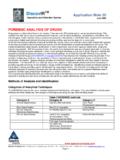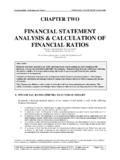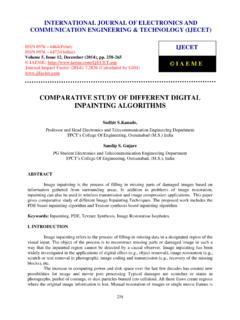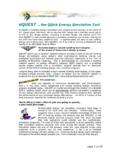Transcription of ELECTRONIC SELF-CHECKOUT SYSTEM VS …
1 ELECTRONIC SELF-CHECKOUT SYSTEM VS cashier OPERATED SYSTEM : A PERFORMANCE BASED comparative analysis by Gregory E. Opara-Nadi A Dissertation Presented in Partial Fulfillment Of the Requirements for the Degree Doctor of Philosophy Capella University May, 2005 Gregory Opara-Nadi, 2005 ELECTRONIC SELF-CHECKOUT SYSTEM VERSUS cashier OPERATED SYSTEM : A PERFORMANCE BASED comparative analysis by Gregory E. Opara-Nadi has been approved May 2005 APPROVED: JIM MIRABELLA, , Faculty Mentor and Chair ALISA MOSLEY, , Committee Member NORBERTO CRUZ, , Independent Reviewer DAL DIDIA, , Visiting Professor DELLROY BIRCH, Peer Learner ACCEPTED AND SIGNED: JIM MIRABELLA, Kurt Linberg, Executive Director, School of Business Abstract Customers want fast checkout systems.
2 Retailers are always searching for ways to improve store checkout systems. This study compared the cashier checkout and the ELECTRONIC self -check out systems. Data for this study were collected by observations of checkout processes at Wal-Mart Super Centers in the Jackson, Mississippi, area. Formulated research questions were statistically tested employing the independent samples t-tests and the chi square test for independence. Results of these analyses showed that consumers preferred the cashier checkout SYSTEM to the ELECTRONIC SELF-CHECKOUT SYSTEM , although shoppers also want to learn how to use the new SELF-CHECKOUT technology. Further studies were suggested on methods of introducing new Point of Sale technology to consumers, and ways to help managers compare costs of checkout systems.
3 Iii Dedication This dissertation is dedicated in memory of my late parents Chief Phillip Opara-Nadi and Chief/Mrs. Helen A. Opara-Nadi. iv Acknowledgments As this journey comes to an end; it would be great if I acknowledge everyone who helped make this journey a success. I know that I cannot recognize everyone of these individuals here. However, I am sincerely grateful to all these wonderful people. I would like to express my appreciation and thanks to the members of my dissertation committee Dr. Alicia A. Mosley, Dr. Norberto Cruz, Dr Dal Didia and Mr. Dellroy Birch. Thanks for your guidance and untiring efforts in reviewing my work and steering me toward the right direction through the process of this dissertation.
4 A special thanks to Dr. James Mirabella, you are the greatest, your inspiration, support, encouragement, and willingness to mentor and chair my dissertation process. I would also like to express my gratitude to Miss Sandra Parker Allen, a friend and a coworker, and Dr. Ancilla Coleman for their special support during my dissertation process. Furthermore, I would like to express gratitude to the wonderful and inspiring professors during my graduate studies. Finally, I want to acknowledge members of my family, especially my granddaughter Crystalie; my three sons Brian, Christopher, and Joseph; and my wife Hattie S. Opara-Nadi for her love, encouragement and tireless effort in making this journey a success.
5 I love you all. v Table of Contents Dedication iii Acknowledgment iv Table of Contents v List of Tables ix List of Figures x Title Page xi CHAPTER 1: INTRODUCTION 1 Background of the Problem 1 Statement of the Problem 4 Purpose of the Study 5 Research Questions 6 Research Hypothesis 7 Significance of the Study 8 Definition of Terms 9 Assumptions and Limitations 11 Nature and Conceptual Framework of the Study 11 CHAPTER II: REVIEW OF LITERATURE 13 Factors influencing length of time customers spend waiting in line 13 Time Wasted (Idle Time)
6 In Grocery Lines 14 vi The Queuing Experience 14 Consumer s Perception on Filled and Empty Time 16 Attribution and Affective Reactions 19 Perception and Influences on Customers Preference 22 Service Relationships and Evaluations 24 The Psychology of Combining Queues 27 Queues, Affective Experience, Satisfaction, and Decisions 28 History of the Queuing Theory and Waiting Line Techniques 31 Queuing and Waiting Line Problems 31 Single-Server Queuing Models 33 Queuing Discipline 34 Causes of Waiting in Line 35 Methods of Managing Queues 37 Queuing Theory and the Psychological Cost of Waiting 38 Customer Relationship 40 Factors That Influence Managerial Decision-Making Processes 46 SELF-CHECKOUT SYSTEM in Retail Stores 47 Retail Hardware 47 SELF-CHECKOUT in Retail POS 49 Consumer s Experience with SELF-CHECKOUT Systems 50 The Future of checkout Systems 54
7 Vii Fujitsu's SELF-CHECKOUT SYSTEM Reduces Costs and Increases Shoppers' Convenience 55 Managerial Decisions on POS Equipment 56 Summary of Literature Review 59 CHAPTER III: METHODOLOGY 61 Sample Design 61 Research Design 63 Research Instrument 64 Research Hypothesis 64 Sub Research Hypotheses 64 Data Collection 65 Data analysis 66 CHAPTER IV: DATA COLLECTION, analysis AND PRESENTATION OF FINDINGS 66 analysis and Presentation of Findings 67 Sub Research Hypothesis 67 Data Collection 68 Descriptive Statistics 69 analysis and Findings 70 Sub Hypothesis One 71 Sub Hypothesis Two 72 Sub Hypothesis Three 74 viii Sub Hypothesis Four 75 Sub Hypothesis Five 75 Sub Hypothesis Six 76 Research Hypothesis 77 CHAPTER V: SUMMARY, CONCLUSIONS, AND RECOMMENDATIONS 79 Research Findings 81 Suggestions for further research 84 Appendices 86 Table A-1.
8 Contingency Table on Error Rates 86 Table A-2: Customer Affective Response Percentage of Preference 86 Table A-3: Managers Affective Response 86 Supper-Market Supplemental Survey Questionnaire Responses 87 Pilot Study Survey Instrument 89 References 90 ix List of Tables Table 1-1: Results on Average Number of Items Checked Out 72 Table 2-1: Results on Average Length of checkout Time 73 Table 3-1: Chi Square Test for Independence on Error Rates 74 Table 4-1: Customers Affective Reactions and Confidence 76 Table 5-1: Result of Responses from Managers 77 x List of Figures Figure 1: The Basic Theoretical Framework (Hui, Thakor, and Gill, 1998) 21 Figure 2: An Integrative Model of Waiting Information and Service Evaluation (Hui and Tse 1996) 26 xi Dissertation Topic ELECTRONIC SELF-CHECKOUT SYSTEM Vs cashier Operated SYSTEM : A Performance Based comparative analysis The Search for the Better Line CHAPTER I.
9 INTRODUCTION Background of the Problem The consumer-buying pattern is influenced by several factors including the length of time the consumer spends waiting in line at the checkout counter. Retailers and businesses that use checkout systems in their businesses spend considerable resources searching for ways to improve their methods of customer checkout . Nevertheless, there is an overwhelming need for businesses to value customers time and install more efficient checkout systems to improve the efficiency of queues and waiting lines. A 1990 survey by the Food Marketing Institute (Alcott, 1991) reported that 89% of shoppers interviewed indicated that a fast checkout process is one of the top priorities in their choice of a store that meets their expectations.
10 The issue of improving customers checkout process is not a new phenomenon. Managers in the retail industry have been tackling the problem of improving customers checkout systems. This concern contributed to one of the earliest inventions for keeping track of commercial transactions and checking out customers on a timely manner. The abacus helped early merchants make arithmetic calculation and checkout customers in the process. A variety of abacus designs followed and led to the present checkout machines used in the retail stores today. The other dimension in the history of the checkout process involved how managers decide on what SYSTEM to implement to reduce the length of lines and time customers spend in checkout lanes.









